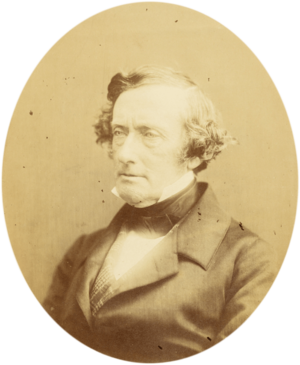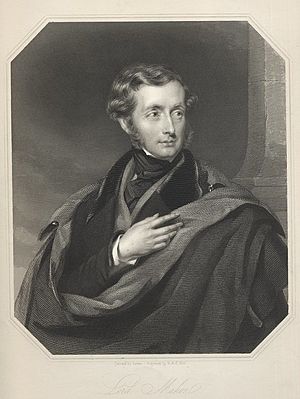Philip Stanhope, 5th Earl Stanhope facts for kids
Quick facts for kids
The Earl Stanhope
|
|
|---|---|

Stanhope in 1857
|
|
| Born |
Philip Henry Stanhope
30 January 1805 Walmer, Kent, England
|
| Died | 24 December 1875 (aged 70) Bournemouth, Hampshire, England
|
| Nationality | British |
| Other names | Viscount Mahon (1816–1855) |
| Alma mater | Christ Church, Oxford |
| Known for | Contributions to cultural causes and for his historical writings |
| Political party | Tory |
| Spouse(s) |
Emily Kerrison
(m. 1834; died 1873) |
| Children | 5; including Arthur, Edward and Philip |
| Parent(s) | |
| Under-Secretary of State for Foreign Affairs | |
| In office 17 December 1834 – 8 April 1835 |
|
| Monarch | William IV |
| Prime Minister | Sir Robert Peel |
| Preceded by | Viscount Fordwich |
| Succeeded by | William Fox-Strangways |
Philip Henry Stanhope, 5th Earl Stanhope (born January 30, 1805 – died December 24, 1875) was an important English historian and politician. He was also known as Viscount Mahon for most of his life, until 1855.
He served in the British government for a short time. However, he is best remembered for his work in history and for helping to create important cultural places. He was a Fellow of the Royal Society, which is a group of top scientists.
Contents
Early Life and Education
Philip Henry Stanhope was born in Walmer, Kent, England. His father was Philip Stanhope, 4th Earl Stanhope.
He went to Christ Church, Oxford, a famous university. He finished his studies there in 1827.
Political Journey
Stanhope became a member of Parliament in 1830. He first represented a place called Wootton Basset. This area was known as a "rotten borough," meaning it had very few voters but still had a representative in Parliament.
After 1832, he represented Hertford. He worked for Sir Robert Peel, who was a Prime Minister. Stanhope was an Under-Secretary of State for Foreign Affairs from 1834 to 1835. He also served as Secretary to the Board of Control in 1845.
Even though he stayed in the House of Commons until 1852, he was not very well known for his political work.
Helping Culture and History
Stanhope's biggest achievements were in literature and history. He helped pass a law in 1842 called the Literary Copyright Act. This law helped protect the rights of writers.
From the House of Lords, he played a key role in starting the National Portrait Gallery, London in 1856. This gallery displays portraits of famous British people. You can even see a sculpture of him above the entrance!
He also helped start the Historical Manuscripts Commission in 1869. This group works to find and preserve old historical documents. As president of the Society of Antiquaries, he encouraged people to support archaeological digs, like the ones at Troy.
Stanhope was also a trustee of the British Museum, a very famous museum. He also created the Stanhope essay prize at Oxford University in 1855, which is a prize for history essays.
His Writings
Lord Stanhope wrote many important books about history. Some of his most famous works include:
- Life of Belisarius (1829) – about a famous general.
- History of the War of the Succession in Spain (1832) – about a war in Spain.
- History of England from the Peace of Utrecht to the Peace of Versailles, 1713–1783 (7 volumes) (1836–1853) – a long history of England.
- Life of the Right Honourable William Pitt (4 volumes) (1861–1862) – about a former Prime Minister.
- The Reign of Queen Anne until the Peace of Utrecht, 1701–1713 (1870) – about Queen Anne's time.
- Notes of Conversation with the Duke of Wellington, 1831–1851 (1886) – his notes from talking with the famous Duke of Wellington.
He also wrote a shorter book called The Forty-Five. This book was about the Jacobite rising of 1745, a rebellion in Scotland.
Stanhope was able to access special old papers for his books, which made his historical writings very valuable. His notes about the Duke of Wellington were also important because the Duke never wrote his own memoirs.
Family Life
Lord Stanhope married Emily Harriet Kerrison in 1834. She passed away in December 1873.
They had five children together:
- Arthur Stanhope, 6th Earl Stanhope (1838–1905)
- Hon. Edward Stanhope (1840–1893), who also became a well-known politician.
- Lady Mary Catharine Stanhope (1844–1876)
- Hon. Henry Augustus Stanhope (1845–1933)
- Philip Stanhope, 1st Baron Weardale (1847–1923)
Philip Henry Stanhope died in December 1875, at the age of 70. His eldest son, Arthur, took over his title as Earl Stanhope.


